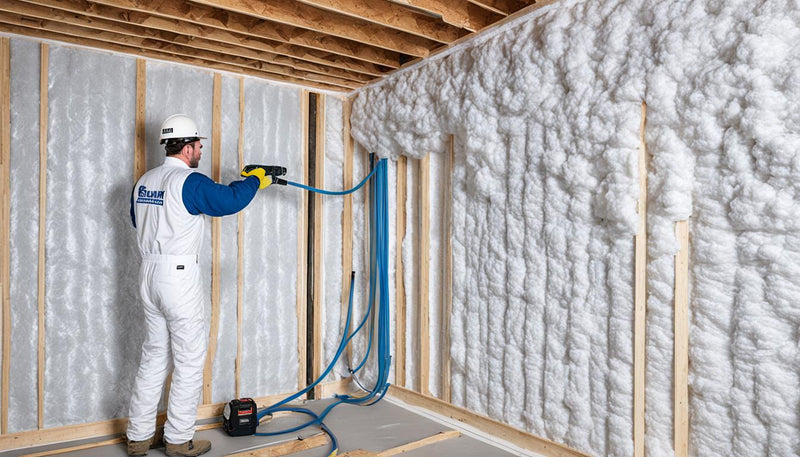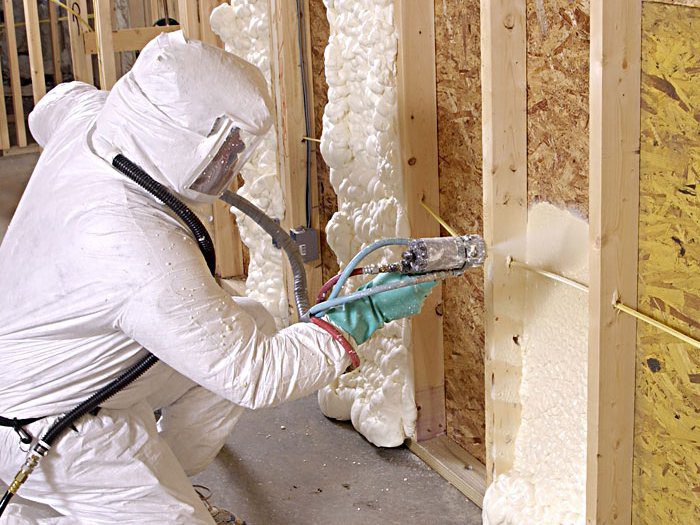Understanding the Benefits of Using Spray Foam for Insulation Projects
Understanding the Benefits of Using Spray Foam for Insulation Projects
Blog Article
Spray Foam: The Ultimate Solution for Air Sealing and Insulation
Spray foam insulation has become a leading solution for reliable air securing and thermal insulation, offering an unique combination of homes that set it aside from standard techniques. Its ability to increase and load gaps makes it particularly efficient in preventing air leakage, which can considerably influence energy performance. Recognizing the full extent of its advantages, installment procedures, and contrasts with various other insulation kinds is important for making informed choices. As we discover these elements, the implications for both new constructions and retrofits become significantly considerable. What aspects should influence your selection?
What Is Spray Foam?
Spray foam is a flexible insulation material that combines the principles of air sealing and thermal resistance to boost energy performance in structures. Composed largely of polyurethane or various other similar compounds, spray foam is used as a fluid that broadens upon call with surface areas, developing a strong, constant layer of insulation. This one-of-a-kind residential property allows it to load gaps, cracks, and gaps that conventional insulation products may ignore, giving a superior air seal.
There are 2 main kinds of spray foam: open-cell and closed-cell. Open-cell spray foam is lighter and a lot more flexible, using exceptional audio absorption and a lower R-value per inch - Spray Foam. On the other hand, closed-cell spray foam is denser, supplying a higher R-value, moisture resistance, and added structural integrity to constructing components
The application process commonly entails customized equipment, ensuring a seamless application that adheres to different substratums, consisting of steel, timber, and concrete. This versatility makes spray foam appropriate for both new constructions and retrofitting existing structures. Its capability to develop an airtight obstacle dramatically contributes to decreasing energy intake and boosting interior air top quality, thereby making it a favored selection among building contractors and house owners alike.
Benefits of Spray Foam Insulation
Among the most substantial advantages of spray foam insulation is its extraordinary capacity to produce a continual air barrier, which successfully reduces energy loss. Unlike traditional insulation products, spray foam expands to fill spaces and fractures, making certain that air leak is drastically minimized. This particular not just boosts energy efficiency however also causes reduce utility expenses over time.
Furthermore, spray foam insulation provides exceptional thermal resistance, contributing to a more stable interior setting. Its high R-value per inch permits for efficient insulation in constrained rooms, making it optimal for attics, wall surfaces, and crawl spaces. The moisture-resistant residential properties of spray foam aid prevent mold and mold development, promoting healthier living conditions.
One more essential benefit of spray foam insulation is its sound-dampening qualities (Spray Foam). It effectively minimizes noise transmission between areas, producing a quieter and a lot more comfortable home environment. The resilience of spray foam likewise sticks out, as it does not droop or settle in time, maintaining its performance throughout its lifespan
Exactly How Spray Foam Works
Understanding how spray foam insulation functions is necessary for appreciating its effectiveness in air securing and thermal resistance. Spray foam insulation includes 2 primary components: isocyanate and polyol material. When these components are combined, they undergo a chemical reaction that causes the product to increase swiftly, producing a dense foam that fills up dental caries, spaces, and fractures.
As the foam expands, it sticks to surfaces, forming an impermeable seal that dramatically minimizes air infiltration. This characteristic makes spray foam insulation highly effective at stopping drafts and dampness infiltration, which can result in power loss and damages in time. Furthermore, the closed-cell version of spray foam uses premium thermal resistance as a result of its inflexible framework, effectively reducing warmth transfer.
The unique homes of spray foam enable it to comply with uneven surface areas, making sure detailed coverage and a smooth obstacle. As a result, spray foam insulation not just boosts energy performance however also adds to boosted interior air top quality by decreasing the buildup of allergens and toxins. Inevitably, understanding the auto mechanics behind spray foam underscores its role as a premium option for insulation and air securing in both property and business applications.
Setup Refine Overview

Before installation, the space should be adequately cleansed and prepped, making sure that surface areas are free from dust, particles, and dampness. This step is important since impurities can compromise adhesion and total efficiency. When the area is prepared, the application involves blending the two elements of the spray foam, which expands upon contact and fills spaces effectively.
Trained experts must conduct the setup, making use of customized equipment to make certain consistent protection and optimal thickness. Security preventative measures, including using safety equipment and making sure correct air flow, are important during this process. After application, the foam generally treatments swiftly, creating a solid barrier that boosts energy effectiveness.
Comparing Spray Foam to Standard Insulation
When assessing insulation options, spray foam insulation stands out in comparison to traditional materials such as fiberglass and cellulose. Unlike fiberglass and cellulose, which can enable air seepage, spray foam expands upon application, filling up spaces and gaps to develop a closed seal.
In addition, spray foam offers a higher R-value per inch than typical insulation types, using more effective thermal resistance in a thinner profile. This characteristic is especially useful in spaces with limited tooth cavity depth. In addition, spray foam is immune to dampness and mold growth, which can be a considerable worry with cellulose and fiberglass, particularly in humid settings.
However, spray foam insulation typically brings a greater ahead of time price than its conventional counterparts. Home owners should consider this initial investment against long-term energy financial savings and efficiency advantages. Ultimately, while both insulation kinds serve their function, spray foam arises as an advanced solution for modern-day insulation demands, particularly in regards to air securing and thermal performance.

Verdict
In summary, spray foam insulation stands for a very efficient remedy for accomplishing optimal air sealing and thermal Learn More resistance. Its unique residential properties, consisting of dampness resistance and noise dampening, make it suitable for numerous applications in both brand-new buildings and retrofitting jobs (Spray Foam). Although the preliminary costs might be greater compared to conventional insulation products, the lasting benefits, such as significant energy financial savings and boosted Clicking Here indoor air top quality, validate the investment and underscore its worth in modern-day structure techniques.
Spray foam insulation has actually emerged as a leading option for effective air securing and thermal insulation, supplying a distinct combination of residential properties that set it apart from typical methods.Spray foam is a flexible insulation material that integrates the principles of air securing and thermal resistance to enhance power performance in structures.When assessing insulation choices, spray foam insulation stands out in contrast to standard materials such as fiberglass and cellulose. Inevitably, while both insulation kinds serve their purpose, spray foam emerges as a more sophisticated option for modern insulation needs, especially in you could try this out terms of air securing and thermal performance.
In summary, spray foam insulation stands for a highly effective remedy for achieving optimum air sealing and thermal resistance.
Report this page